We’re exploring the the latest and greatest in yacht design trends this year. From folding transoms and “floating beach clubs” to kite-powered mega yachts, we’ll examine the top 5 coolest and most exciting design themes of the year.
1. Wellness and Active Lifestyle
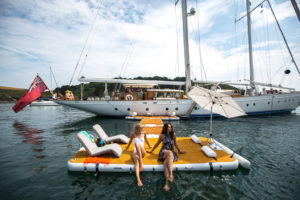
The pandemic has created a greater global awareness and focus on our mental and physical wellbeing. According to Precedence Research, the wellness tourism market size is predicted to surpass $1.6 trillion by 2030. The popularity and demand for health and wellness offerings extends into the yacht design world as well.
More and more yacht designs are built around complimenting a healthy and active lifestyle. In the superyacht world, we see a growing demand for onboard spas complete with cryo chambers, spa pools, steam showers, massage rooms, hammams, and elaborate fitness centers.
Deck design is being reimagined to incorporate a greater demand for active lifestyles. Large open decks bring greater opportunity for outdoor recreation. New designs in boarding platforms improve ease of access to the water for recreational activities while “floating beach clubs” such as Nautibuoy floating platforms provide basecamps with expandable configurations for waterside activities including snorkeling, diving, and paddle boarding.
This wellness theme extends to the dinner table and kitchen as well. Gone are the days of the small ship galley tucked out of sight. In vogue are designs that emphasize the joy of cooking with big open layouts and countertops that integrate cooking, dining, and socializing into one seamless experience. New designs also toss out the idea that outdoor cooking should be limited to a small BBQ grill. Innovative on-deck and outdoor galley spaces provide a full open-air gourmet cooking experience (see our work on Cirrus below) complete with pizza ovens, storage, refrigeration, and premium cooking elements.
2. Sustainable Materials
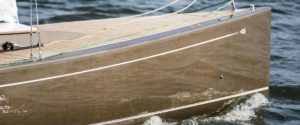
The Flax 27 features cork decks with pigment-free resin and rolled gunwales, which show off the pattern of the woven flax cloth. Designed by Judel/Vrolijk-designed and built by Greenboats from Bremen, Germany.
The push for sustainability has come to the forefront for many yacht designers and builders, including us! With growing consumer awareness and demand for sustainable products, designers and builders have embarked on a revolution to integrate new materials, systems, and design ideas.
New materials like flax and basalt fibers, bio-resins, and recycled core are increasingly being researched as alternatives to chemically intensive, toxic, and unsustainable materials. This new generation of eco-friendly materials can effectively have fibers and resins separated and recycled allowing them to be reused on new boats rather than going into landfills at the end of a boat’s lifespan.
A new focus has also been placed on one of the most traditional boat building materials, wood. Wood products store carbon, helping to mitigate climate change while also providing a good alternative for materials that require large amounts of fossil fuels to produce.
Mass timber is wood that has been changed thermally or chemically to enhance its properties. This means trees that wouldn’t normally be considered optimal choices are modified to fill in for the more desirable, expensive and less sustainable hardwoods. Products such as Lignia are being used to replace slow-growing decorative woods such as teak, with similar durability and aesthetic.
Even rigid inflatable boats are replacing traditional material with bio-based infused epoxy resin that will be reinforced with naturally sourced basalt and flax fibers.
3. Hybrid Propulsion
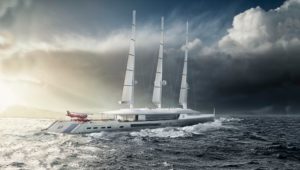
Norse is a 262-foot sail-assisted explorer concept designed by Oliver Stacy, which draws on auxiliary wind power for passage making.
As concerns about environmental and ecological impact rise, many boat owners are seeking modern propulsion systems that minimize CO2 output while preserving power and function. Boat designers are answering with manufacturers’ innovative propulsion products and integrating these models into the design process.
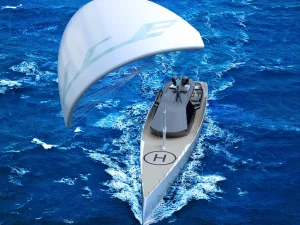
Ice Kite was conceived collaboratively by Red Yacht Design, Dijkstra Naval Architects, and the anonymous German entrepreneur commissioning it.
On many sail and powerboats, more designs feature electric and hybrid propulsion systems. Advancements in technologies for lithium battery architecture results in more power density. When a system is blended with solar and electric motors, we have the possibility of short duration “silent yachts”. In 2010, Köhler’s Solarwave 46 became the world’s first solar powered yacht. Since then, bigger players have jumped into the game making electric powered propulsion systems an increasingly viable option, even on the largest of yachts.
4. Convertible Sections and Improved Water Access
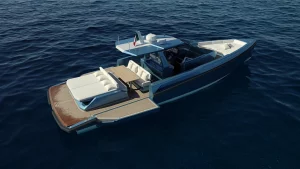
48 Wallytender designed by Wally featuring fold-down bulwark sections and restartable passarelle doubling as a 5-step swim ladder.
One of the fastest-growing trends in boat design over the past few years has been the chase to find usable space on board. We’ve seen this particularly with the design of cockpits, swim platforms and the sterns on board recreational boats. The trend started in megayacht construction, with large convertible deck arrangements and tricky door solutions that reveal large storage or lounging spaces. We’ve seen this filter down to the 30-50 foot ranges of recreational power boats, cruisers, and sailboats.
Newer, more innovative designs include convertible sections of hull and deck that significantly expand deck space, opening up larger areas for play and recreation. These hinging, or sliding arrangements also bring the user-experience right to the water, creating a private beach club environment that is the perfect springboard for fishing and recreational activities.
As early adopters of this concept, we designed an elegant fold-down boarding platform on 90-ft Bequia, which launched in 2009. We’re currently integrating an even more sophisticated fold-down transom on Cirrus, which features a large garage storage area, easy water access, and a Techimplex electric grill and carbon composite countertop that travels on heavy duty drawer-slides to create a functional outdoor galley.
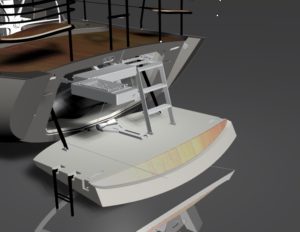
The transom platform we designed for Cirrus presents a significantly-sized aft “porch” for cooking, fishing, sitting, sunning, jumping off, climbing aboard from the water, or stepping aboard from the dinghy.
Read more about the modern transom
5. Refurbishment and Refresh
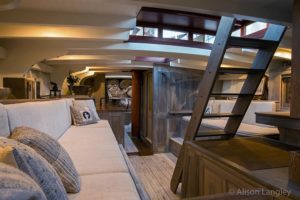
Renovated interior of the 60-ft Marilee built in 1926 by Nathanael Herreshoff. Refurbished in 2014 by French and Webb with Kurt Hasselbalch with design consultation from Stephens Waring. Photo credit: Alison Langley.
With the popularity of boating and boat ownership at a 13-year high, many consumers are searching for the right way to get into the market. Like purchasing a vehicle, there are pros and cons for purchasing new, used, or custom-design vessels.
While many owners will demand the latest and greatest from their boat, there are many often overlooked benefits and considerations for the used and refurbished yacht market. Of course, cost and budget are always primary drivers, but there are other benefits that go beyond that as well.
When talking to prospective boat buyers, they often feel that a boat, like a car, is fixed with respect to its design and finishes. However, there is a new trend to look at boats more like homes, which provide a broad canvas for renovations and remodels.
There are a variety of cost and environmental benefits to refurbishment over new boats. As boat disposal becomes a larger issue, refurbishment reduces landfill waste and requires significantly less resources than building from scratch. There is also an intangible sentimental value to restoration that provides an owner a feeling of connection to history, heritage and simply a cool factor.
More designers are looking at how renovations can be accomplished efficiently. These range from superficial changes to paint and fixtures, to major overhauls of structure, systems, and powerplants. Renovations often provide a best-of-all-world’s solution that is cost-effective, environmentally sound, and adds a premium layer of comfort, safety, and advanced technology.
Stay-tuned for some exciting Stephens Waring refurbishment project news.
Read more about other Stephens Waring renovation projects: